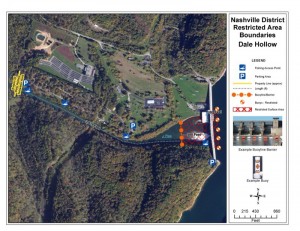Corps’ plans to restrict fishing near dams will affect Dale Hollow Lake
By THOMAS P. WEAVER
HORIZON Editor
CELINA-News of plans by the Corps of Engineers to restrict fishing near dams in the region broke late last year, but details have recently emerged showing the reach of the proposals.
If the Corps has their way, signs, barriers, and buoys be installed above and below dams all over Middle Tennessee and Kentucky, including here on Dale Hollow Lake ending anglers’ access to what many local fisherman see as some of the best fishing around.
“There’s a lot of trout fishermen who fish up close to the dam on the lake side and others who do in the river below,” local tackle store owner and angler Stephen Headrick said. “This is a big deal and will eventually have an impact on our already tough local economy.”
Headrick, the owner of Dale Hollow 1-Stop and Punisher Lures, said not only will it affect his business, but many others.
“The majority of campers in the campground below the dam come to fish and others come stay at docks in Celina because they are close to the dam where the best trout fishing is,” he said. “If you take that away, not only will my business feel it, but all of the restaurants, stores, and other businesses in town will be affected.
“We all need to show our opposition to this and stop it.”
Many anglers and others opposed to the Corps’ proposed restrictions have done just that at a pair of public hearings hosted by the Corps–one in Kentucky and the most recent held last week in Baxter. Over 200 attended the Kentucky meeting and the Baxter gathering also featured large numbers of those in opposition of the proposal.
 Locally, anglers can expect to see waters below Dale Hollow Dam closed from the structure 500 feet downstream and 100 feet from the dam on the lake side.
Locally, anglers can expect to see waters below Dale Hollow Dam closed from the structure 500 feet downstream and 100 feet from the dam on the lake side.
A rendering of the specifics of the areas to be restricted accompanies this story and graphics detailing other affected lakes can be found at www.lrn.usace.army.mil.
The possible closures are being implimented to bring the Nashville District “into full compliance” with Corps regulations, a release announcing the Corps’ plans on their website said.
The same information explained the restricted areas will be the minimum area allowed per Corps regulations upstream and downstream of locks, dams, and power plant facilities.
“All forms of water access within the restricted areas will be prohibited including boating, swimming and wading,” the release said. “The Corps continues to allow bank fishing in all areas that were previously approved, including areas adjacent to some restricted areas.”
“We understand the tightened restricted areas in the Nashville District may be unpopular, but it is necessary for the district to enforce a more restrictive policy that complies more effectively with U.S. Army Corps of Engineers’ ER 1130-2-520, Chapter 10,” Freddie Bell, chief of the Natural Resource Management Branch, said in the December 13, 2012 announcement. “The increased restriction will also provide the highest level of public safety and address physical security issues.”
The Corps sites safety concerns as evidence towards the relevance of the restrictions.
“Since 2009, three fatalities, one serious injury and 10 near misses/rescues have occurred in the hazardous waters immediately downstream of dams on the Cumberland River and its adjoining tributaries,” the release said. “Life jacket wear has been ineffective in these areas, since all of the victims who drowned were wearing a life jacket.
“The immediate hazardous water areas above and below dams in the Nashville District are best described as industrial areas that pose a high level of risk for the public because of the hydroelectric, spilling, sluicing and lock operations that are often present or begin with little or no notice. Such water releases can change a dry riverbed or calm waters into a life-threatening situation within seconds that can swamp, capsize and trap boats and people in turbulent waters.”
“We want the public to understand safety is the Agency’s highest priority,” Bell continued in the announcement. “The tailwater directly below a dam is a high risk area and fishing in this area is a high risk activity.
“As we comply with Corps regulations by restricting these areas, we are also keeping the public safe.”
Opponents of the closures have argued the Corps is exaggerating their claims and an account of the Baxter meeting written by Liz Engel Clark and published by the Cumberland Business Journal (CBJ) quoted Tennessee Wildlife Resources Agency (TWRA) chief of fisheries Bobby Wilson debunking some of the Corps’ facts.
In the CBJ story, Engel Clark explained Wilson said “since 1978, there have been seven boating deaths below Tennessee Corps projects. Five of those seven involved boaters who were not wearing life jackets. Of the two who were, one was wearing an inflatable jacket, in which the person did not inflate, and the other didn’t have the lifejacket properly fastened.
“He also said the restriction would have an adverse economic impact. Areas around the dams are considered high-quality fishing zones, “the best in the state,” he noted, many times year-round.”
“There’s little doubt there would be a loss of revenue to local guides, bait shops and similar smaller industries,” Engle Clark quoted Wilson saying. “I don’t have the specific figures on what the loss would be in total, but we believe it will be a significant local impact.”
Two more public information meetings are planned, including January 24 in Somerset, KY and February 5 in Nashville. For more information about the meetings, visit the Corps website at www.lrn.usace.army.mil.
To see Engel Clark’s complete story visit the CBJ’s website at www.ucbjournal.com.
